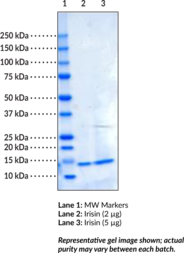Chemicals
Showing 22801–22950 of 41137 results
-
IPI-549 is an inhibitor of PI3Kγ (IC50s = 16, 3,200, 3,500, and >8,400 nM for PI3Kγ, PI3Kα, PI3Kβ, and PI3Kδ, respectively).{42626} It is greater than 100-fold selective for PI3Kγ over a panel of 468 mutant and nonmutant protein and lipid kinases, including Class II PI3K isoforms, and a panel of 80 G protein-coupled receptors, ion channels, and transporters at 10 µM. It inhibits phosphorylation of AKT S473 in SKOV3, 786-0, RAW 264.7, and RAJI cells and inhibits migration of bone marrow-derived macrophages (BMDMs) (IC50 = 85 nM). IPI-549 sensitizes doxorubicin-resistant SW620/Ad300 cells to P-glycoprotein (P-gp) substrates, such as paclitaxel (IC50s = 710 and 6.7 nM for paclitaxel alone and in combination with IPI-549, respectively), and increases the level of intracellular paclitaxel in SW620/Ad300 cells.{42627} It also enhances the tumor growth reduction of paclitaxel (Item No. 10461) in an SW620/Ad300 mouse xenograft model when administered at a dose of 3 mg/kg in combination with paclitaxel.
Brand:CaymanSKU:26416 - 25 mgAvailable on backorder
IPI-549 is an inhibitor of PI3Kγ (IC50s = 16, 3,200, 3,500, and >8,400 nM for PI3Kγ, PI3Kα, PI3Kβ, and PI3Kδ, respectively).{42626} It is greater than 100-fold selective for PI3Kγ over a panel of 468 mutant and nonmutant protein and lipid kinases, including Class II PI3K isoforms, and a panel of 80 G protein-coupled receptors, ion channels, and transporters at 10 µM. It inhibits phosphorylation of AKT S473 in SKOV3, 786-0, RAW 264.7, and RAJI cells and inhibits migration of bone marrow-derived macrophages (BMDMs) (IC50 = 85 nM). IPI-549 sensitizes doxorubicin-resistant SW620/Ad300 cells to P-glycoprotein (P-gp) substrates, such as paclitaxel (IC50s = 710 and 6.7 nM for paclitaxel alone and in combination with IPI-549, respectively), and increases the level of intracellular paclitaxel in SW620/Ad300 cells.{42627} It also enhances the tumor growth reduction of paclitaxel (Item No. 10461) in an SW620/Ad300 mouse xenograft model when administered at a dose of 3 mg/kg in combination with paclitaxel.
Brand:CaymanSKU:26416 - 5 mgAvailable on backorder
Ipragliflozin is a sodium-glucose cotransporter 2 (SGLT2) inhibitor (IC50 = 7.4 nM in CHO cells expressing the human cotransporter).{49504} It is selective for SGLT2 over SGLT1, SGLT3, SGLT4, SGLT5, and SGLT6 (IC50s = 1.9, 30.4, 15.9, 0.46, and 10.4 µM, respectively). Ipragliflozin (0.1-3 mg/kg) decreases plasma levels of insulin and glucose in an oral glucose tolerance test in a mouse model of diabetes induced by high-fat diet, streptozotocin (STZ; Item No. 13104), and nicotinamide (Item No. 11127).{49505} It decreases plasma and hepatic IL-6, TNF-α, chemokine (C-C motif) ligand 2 (CCL2), and C-reactive protein (CRP) levels in the same model when administered at a dose of 3 mg/kg per day for 28 days.
Brand:CaymanSKU:22287 -Out of stock
Ipragliflozin is a sodium-glucose cotransporter 2 (SGLT2) inhibitor (IC50 = 7.4 nM in CHO cells expressing the human cotransporter).{49504} It is selective for SGLT2 over SGLT1, SGLT3, SGLT4, SGLT5, and SGLT6 (IC50s = 1.9, 30.4, 15.9, 0.46, and 10.4 µM, respectively). Ipragliflozin (0.1-3 mg/kg) decreases plasma levels of insulin and glucose in an oral glucose tolerance test in a mouse model of diabetes induced by high-fat diet, streptozotocin (STZ; Item No. 13104), and nicotinamide (Item No. 11127).{49505} It decreases plasma and hepatic IL-6, TNF-α, chemokine (C-C motif) ligand 2 (CCL2), and C-reactive protein (CRP) levels in the same model when administered at a dose of 3 mg/kg per day for 28 days.
Brand:CaymanSKU:22287 -Out of stock
Ipragliflozin is a sodium-glucose cotransporter 2 (SGLT2) inhibitor (IC50 = 7.4 nM in CHO cells expressing the human cotransporter).{49504} It is selective for SGLT2 over SGLT1, SGLT3, SGLT4, SGLT5, and SGLT6 (IC50s = 1.9, 30.4, 15.9, 0.46, and 10.4 µM, respectively). Ipragliflozin (0.1-3 mg/kg) decreases plasma levels of insulin and glucose in an oral glucose tolerance test in a mouse model of diabetes induced by high-fat diet, streptozotocin (STZ; Item No. 13104), and nicotinamide (Item No. 11127).{49505} It decreases plasma and hepatic IL-6, TNF-α, chemokine (C-C motif) ligand 2 (CCL2), and C-reactive protein (CRP) levels in the same model when administered at a dose of 3 mg/kg per day for 28 days.
Brand:CaymanSKU:22287 -Out of stock
Ipragliflozin is a sodium-glucose cotransporter 2 (SGLT2) inhibitor (IC50 = 7.4 nM in CHO cells expressing the human cotransporter).{49504} It is selective for SGLT2 over SGLT1, SGLT3, SGLT4, SGLT5, and SGLT6 (IC50s = 1.9, 30.4, 15.9, 0.46, and 10.4 µM, respectively). Ipragliflozin (0.1-3 mg/kg) decreases plasma levels of insulin and glucose in an oral glucose tolerance test in a mouse model of diabetes induced by high-fat diet, streptozotocin (STZ; Item No. 13104), and nicotinamide (Item No. 11127).{49505} It decreases plasma and hepatic IL-6, TNF-α, chemokine (C-C motif) ligand 2 (CCL2), and C-reactive protein (CRP) levels in the same model when administered at a dose of 3 mg/kg per day for 28 days.
Brand:CaymanSKU:22287 -Out of stock
Ipratropium is a muscarinic receptor antagonist (IC50s = 2.9, 2, and 1.7 nM for M1, M2, and M3 receptors, respectively).{47807} It inhibits acetylcholine-induced bronchospasm in anesthetized guinea pigs (EC50 = 68 μg/ml). Aerosolized ipratropium (0.2 mg/20 ml) prevents increases in airway resistance in a rat model of cadmium inhalation-induced chronic pulmonary inflammation with airspace enlargement and reduces neutrophil counts and total cell numbers in bronchoalveolar lavage fluid (BALF) and airspace enlargement in lungs when administered in combination with formoterol (Item No. 15584).{47808} Formulations containing ipratropium have been used in the treatment of bronchospasm associated with chronic obstructive pulmonary disease.
Brand:CaymanSKU:29423 - 100 mgAvailable on backorder
Ipratropium is a muscarinic receptor antagonist (IC50s = 2.9, 2, and 1.7 nM for M1, M2, and M3 receptors, respectively).{47807} It inhibits acetylcholine-induced bronchospasm in anesthetized guinea pigs (EC50 = 68 μg/ml). Aerosolized ipratropium (0.2 mg/20 ml) prevents increases in airway resistance in a rat model of cadmium inhalation-induced chronic pulmonary inflammation with airspace enlargement and reduces neutrophil counts and total cell numbers in bronchoalveolar lavage fluid (BALF) and airspace enlargement in lungs when administered in combination with formoterol (Item No. 15584).{47808} Formulations containing ipratropium have been used in the treatment of bronchospasm associated with chronic obstructive pulmonary disease.
Brand:CaymanSKU:29423 - 50 mgAvailable on backorder
Ipriflavone (Item No. 26319) is an analytical reference standard categorized as an aromatase inhibitor and synthetic isoflavone.{46133} This product is intended for research and forensic applications.
Brand:CaymanSKU:26319 - 1 mgAvailable on backorder
Ipriflavone (Item No. 26319) is an analytical reference standard categorized as an aromatase inhibitor and synthetic isoflavone.{46133} This product is intended for research and forensic applications.
Brand:CaymanSKU:26319 - 5 mgAvailable on backorder
Ipsapirone is a partial agonist of the serotonin (5-HT) receptor 5-HT1A (Ki = 10 nM in hippocampal membranes).{35118} It reduces 5-HT release in rat ventral hippocampus in vivo.{35119} Low doses of ipsapirone decrease, while high doses increase, extracellular dopamine release in murine nucleus accumbens.{35120} Extracellular dopamine levels in murine striatum increase following administration of ipsapirone at concentrations >0.1 mg/kg. Ipsapirone has anxiolytic effects in vivo, inhibiting foot shock-induced aggression and passive avoidance behavior in rats (ED50s = 2.2 and 0.5 mg/kg, respectively).{35121} Formulations containing ipsapirone have been used to treat depression and borderline personality disorder.{35122}
Brand:CaymanSKU:22075 -Out of stock
Ipsapirone is a partial agonist of the serotonin (5-HT) receptor 5-HT1A (Ki = 10 nM in hippocampal membranes).{35118} It reduces 5-HT release in rat ventral hippocampus in vivo.{35119} Low doses of ipsapirone decrease, while high doses increase, extracellular dopamine release in murine nucleus accumbens.{35120} Extracellular dopamine levels in murine striatum increase following administration of ipsapirone at concentrations >0.1 mg/kg. Ipsapirone has anxiolytic effects in vivo, inhibiting foot shock-induced aggression and passive avoidance behavior in rats (ED50s = 2.2 and 0.5 mg/kg, respectively).{35121} Formulations containing ipsapirone have been used to treat depression and borderline personality disorder.{35122}
Brand:CaymanSKU:22075 -Out of stock
Ipsapirone is a partial agonist of the serotonin (5-HT) receptor 5-HT1A (Ki = 10 nM in hippocampal membranes).{35118} It reduces 5-HT release in rat ventral hippocampus in vivo.{35119} Low doses of ipsapirone decrease, while high doses increase, extracellular dopamine release in murine nucleus accumbens.{35120} Extracellular dopamine levels in murine striatum increase following administration of ipsapirone at concentrations >0.1 mg/kg. Ipsapirone has anxiolytic effects in vivo, inhibiting foot shock-induced aggression and passive avoidance behavior in rats (ED50s = 2.2 and 0.5 mg/kg, respectively).{35121} Formulations containing ipsapirone have been used to treat depression and borderline personality disorder.{35122}
Brand:CaymanSKU:22075 -Out of stock
Ipsapirone is a partial agonist of the serotonin (5-HT) receptor 5-HT1A (Ki = 10 nM in hippocampal membranes).{35118} It reduces 5-HT release in rat ventral hippocampus in vivo.{35119} Low doses of ipsapirone decrease, while high doses increase, extracellular dopamine release in murine nucleus accumbens.{35120} Extracellular dopamine levels in murine striatum increase following administration of ipsapirone at concentrations >0.1 mg/kg. Ipsapirone has anxiolytic effects in vivo, inhibiting foot shock-induced aggression and passive avoidance behavior in rats (ED50s = 2.2 and 0.5 mg/kg, respectively).{35121} Formulations containing ipsapirone have been used to treat depression and borderline personality disorder.{35122}
Brand:CaymanSKU:22075 -Out of stock
IPSU is a potent orexin receptor 2 (OX2R) antagonist (Ki = 14.13 nM).{46765} It is selective for OX2R over OX1R (Ki = 512.8 nM). IPSU (50 mg/kg) increases non-rapid eye movement (NREM) sleep in mice.
Brand:CaymanSKU:30007 - 1 mgAvailable on backorder
IPSU is a potent orexin receptor 2 (OX2R) antagonist (Ki = 14.13 nM).{46765} It is selective for OX2R over OX1R (Ki = 512.8 nM). IPSU (50 mg/kg) increases non-rapid eye movement (NREM) sleep in mice.
Brand:CaymanSKU:30007 - 10 mgAvailable on backorder
IPSU is a potent orexin receptor 2 (OX2R) antagonist (Ki = 14.13 nM).{46765} It is selective for OX2R over OX1R (Ki = 512.8 nM). IPSU (50 mg/kg) increases non-rapid eye movement (NREM) sleep in mice.
Brand:CaymanSKU:30007 - 25 mgAvailable on backorder
IPSU is a potent orexin receptor 2 (OX2R) antagonist (Ki = 14.13 nM).{46765} It is selective for OX2R over OX1R (Ki = 512.8 nM). IPSU (50 mg/kg) increases non-rapid eye movement (NREM) sleep in mice.
Brand:CaymanSKU:30007 - 5 mgAvailable on backorder
IPTG is a molecular mimic of allolactose, a lactose metabolite that triggers transcription of the lac operon.{22697} It is used in the concentration range of 100 μM – 1.5 mM to induce protein expression where the gene is under the control of the lac operator and is suitable for use with X-gal or bluo-gal to detect lac gene activity in cloning procedures.{24874}
Brand:CaymanSKU:-IPTG is a molecular mimic of allolactose, a lactose metabolite that triggers transcription of the lac operon.{22697} It is used in the concentration range of 100 μM – 1.5 mM to induce protein expression where the gene is under the control of the lac operator and is suitable for use with X-gal or bluo-gal to detect lac gene activity in cloning procedures.{24874}
Brand:CaymanSKU:-IPTG is a molecular mimic of allolactose, a lactose metabolite that triggers transcription of the lac operon.{22697} It is used in the concentration range of 100 μM – 1.5 mM to induce protein expression where the gene is under the control of the lac operator and is suitable for use with X-gal or bluo-gal to detect lac gene activity in cloning procedures.{24874}
Brand:CaymanSKU:-IPTG is a molecular mimic of allolactose, a lactose metabolite that triggers transcription of the lac operon.{22697} It is used in the concentration range of 100 μM – 1.5 mM to induce protein expression where the gene is under the control of the lac operator and is suitable for use with X-gal or bluo-gal to detect lac gene activity in cloning procedures.{24874}
Brand:CaymanSKU:-IQ-1 is a cell-permeable tetrahydroisoquinolinylidene compound that maintains long-term mouse embryonic stem cell (ESC) pluripotency.{26541} When used at 4 µg/ml with Wnt3a, it allows ESCs to form embryoid bodies that continue to express markers of pluripotency, including α-fetoprotein and β-III tubulin.{26541} IQ-1 blocks the interaction of the protein Naked cuticle with a subunit of the protein phosphatase PP2A, altering signaling through Wnt/β-catenin and maintaining the expression of stem cell markers Oct4, Nanog, and Rex1 in ESCs.{26541}
Brand:CaymanSKU:-IQ-1 is a cell-permeable tetrahydroisoquinolinylidene compound that maintains long-term mouse embryonic stem cell (ESC) pluripotency.{26541} When used at 4 µg/ml with Wnt3a, it allows ESCs to form embryoid bodies that continue to express markers of pluripotency, including α-fetoprotein and β-III tubulin.{26541} IQ-1 blocks the interaction of the protein Naked cuticle with a subunit of the protein phosphatase PP2A, altering signaling through Wnt/β-catenin and maintaining the expression of stem cell markers Oct4, Nanog, and Rex1 in ESCs.{26541}
Brand:CaymanSKU:-IQ-1 is a cell-permeable tetrahydroisoquinolinylidene compound that maintains long-term mouse embryonic stem cell (ESC) pluripotency.{26541} When used at 4 µg/ml with Wnt3a, it allows ESCs to form embryoid bodies that continue to express markers of pluripotency, including α-fetoprotein and β-III tubulin.{26541} IQ-1 blocks the interaction of the protein Naked cuticle with a subunit of the protein phosphatase PP2A, altering signaling through Wnt/β-catenin and maintaining the expression of stem cell markers Oct4, Nanog, and Rex1 in ESCs.{26541}
Brand:CaymanSKU:-IQ-1 is a cell-permeable tetrahydroisoquinolinylidene compound that maintains long-term mouse embryonic stem cell (ESC) pluripotency.{26541} When used at 4 µg/ml with Wnt3a, it allows ESCs to form embryoid bodies that continue to express markers of pluripotency, including α-fetoprotein and β-III tubulin.{26541} IQ-1 blocks the interaction of the protein Naked cuticle with a subunit of the protein phosphatase PP2A, altering signaling through Wnt/β-catenin and maintaining the expression of stem cell markers Oct4, Nanog, and Rex1 in ESCs.{26541}
Brand:CaymanSKU:-IQ-1S (free acid) is an inhibitor of NF-κB/AP-1 (IC50 = 2.3 µM in a reporter assay).{52381} It inhibits TNF-α and IL-6 production in human Mono-Mac-6 cells (IC50s = 1.3 and 3.8 µM, respectively) and isolated human peripheral blood mononuclear cells (PBMCs; IC50s = 2.6 and 5.6 µM, respectively), as well as nitric oxide (NO) production in murine J774-A.1 macrophages (IC50 = 3.1 µM). IQ-1S (free acid) binds to JNKs (Kd = 0.24, 0.36, and 0.1µM for JNK1-3), as well as casein kinase 1δ (CK1δ), PI3Kγ, and MAPK-interacting serine/threonine kinase 2 (MKNK2; Kds = 0.38, 0.47, and 0.92 µM, respectively).
Brand:CaymanSKU:29851 - 10 mgAvailable on backorder
IQ-1S (free acid) is an inhibitor of NF-κB/AP-1 (IC50 = 2.3 µM in a reporter assay).{52381} It inhibits TNF-α and IL-6 production in human Mono-Mac-6 cells (IC50s = 1.3 and 3.8 µM, respectively) and isolated human peripheral blood mononuclear cells (PBMCs; IC50s = 2.6 and 5.6 µM, respectively), as well as nitric oxide (NO) production in murine J774-A.1 macrophages (IC50 = 3.1 µM). IQ-1S (free acid) binds to JNKs (Kd = 0.24, 0.36, and 0.1µM for JNK1-3), as well as casein kinase 1δ (CK1δ), PI3Kγ, and MAPK-interacting serine/threonine kinase 2 (MKNK2; Kds = 0.38, 0.47, and 0.92 µM, respectively).
Brand:CaymanSKU:29851 - 25 mgAvailable on backorder
IQ-1S (free acid) is an inhibitor of NF-κB/AP-1 (IC50 = 2.3 µM in a reporter assay).{52381} It inhibits TNF-α and IL-6 production in human Mono-Mac-6 cells (IC50s = 1.3 and 3.8 µM, respectively) and isolated human peripheral blood mononuclear cells (PBMCs; IC50s = 2.6 and 5.6 µM, respectively), as well as nitric oxide (NO) production in murine J774-A.1 macrophages (IC50 = 3.1 µM). IQ-1S (free acid) binds to JNKs (Kd = 0.24, 0.36, and 0.1µM for JNK1-3), as well as casein kinase 1δ (CK1δ), PI3Kγ, and MAPK-interacting serine/threonine kinase 2 (MKNK2; Kds = 0.38, 0.47, and 0.92 µM, respectively).
Brand:CaymanSKU:29851 - 5 mgAvailable on backorder
Interleukin-1 receptor-associated kinases (IRAKs) are important mediators in the signal transduction of Toll/IL-1 receptor (TIR) family members. Dysregulation of TIR signaling, typified by increased NF-κB activity, results in the development of some cancers and other diseases, making the development of IRAK inhibitors a potential therapeutic strategy. IRAK-1/4 inhibitor is a benzimidazole that disrupts the activity of IRAK-1 and -4 with IC50 values of 0.3 and 0.2 µM, respectively.{29157} It demonstrates IC50 values >10 µM in a panel of 27 other kinases tested.{29157} This compound has been used to inhibit a pro-inflammatory response in microglia isolated from clinically diagnosed Alzheimer’s disease patients.{29158}
Brand:CaymanSKU:-Available on backorder
Interleukin-1 receptor-associated kinases (IRAKs) are important mediators in the signal transduction of Toll/IL-1 receptor (TIR) family members. Dysregulation of TIR signaling, typified by increased NF-κB activity, results in the development of some cancers and other diseases, making the development of IRAK inhibitors a potential therapeutic strategy. IRAK-1/4 inhibitor is a benzimidazole that disrupts the activity of IRAK-1 and -4 with IC50 values of 0.3 and 0.2 µM, respectively.{29157} It demonstrates IC50 values >10 µM in a panel of 27 other kinases tested.{29157} This compound has been used to inhibit a pro-inflammatory response in microglia isolated from clinically diagnosed Alzheimer’s disease patients.{29158}
Brand:CaymanSKU:-Available on backorder
Interleukin-1 receptor-associated kinases (IRAKs) are important mediators in the signal transduction of Toll/IL-1 receptor (TIR) family members. Dysregulation of TIR signaling, typified by increased NF-κB activity, results in the development of some cancers and other diseases, making the development of IRAK inhibitors a potential therapeutic strategy. IRAK-1/4 inhibitor is a benzimidazole that disrupts the activity of IRAK-1 and -4 with IC50 values of 0.3 and 0.2 µM, respectively.{29157} It demonstrates IC50 values >10 µM in a panel of 27 other kinases tested.{29157} This compound has been used to inhibit a pro-inflammatory response in microglia isolated from clinically diagnosed Alzheimer’s disease patients.{29158}
Brand:CaymanSKU:-Available on backorder
Interleukin-1 receptor-associated kinases (IRAKs) are important mediators in the signal transduction of Toll/IL-1 receptor (TIR) family members. Dysregulation of TIR signaling, typified by increased NF-κB activity, results in the development of some cancers and other diseases, making the development of IRAK inhibitors a potential therapeutic strategy. IRAK-1/4 inhibitor is a benzimidazole that disrupts the activity of IRAK-1 and -4 with IC50 values of 0.3 and 0.2 µM, respectively.{29157} It demonstrates IC50 values >10 µM in a panel of 27 other kinases tested.{29157} This compound has been used to inhibit a pro-inflammatory response in microglia isolated from clinically diagnosed Alzheimer’s disease patients.{29158}
Brand:CaymanSKU:-Available on backorder
Irbesartan is an antagonist of the angiotensin II type 1 (AT1) receptor (Ki = 1.3 nM).{21001} It is an insurmountable antagonist of AT1, as its antagonism cannot be overcome by increasing concentrations of angiotensin II.{21393} Irbesartan (3, 10, and 30 mg/kg) reduces blood pressure in stroke-prone spontaneously hypertensive rats and increases survival of SPSH rats fed a high-salt low-protein diet.{43281} It also reduces plaque formation, collagen content, as well as the increased expression of the AT1 receptor, PDGF-b, MCP-1, and VCAM-1 in a model of diabetes-induced atherosclerosis using apolipoprotein E (ApoE) knockout mice with diabetes induced by streptozotocin (STZ; Item No. 13104).{43280} Formulations containing irbesartan have been used, alone and in combination with diuretics, in the treatment of hypertension.
Brand:CaymanSKU:11952 - 10 mgAvailable on backorder
Irbesartan is an antagonist of the angiotensin II type 1 (AT1) receptor (Ki = 1.3 nM).{21001} It is an insurmountable antagonist of AT1, as its antagonism cannot be overcome by increasing concentrations of angiotensin II.{21393} Irbesartan (3, 10, and 30 mg/kg) reduces blood pressure in stroke-prone spontaneously hypertensive rats and increases survival of SPSH rats fed a high-salt low-protein diet.{43281} It also reduces plaque formation, collagen content, as well as the increased expression of the AT1 receptor, PDGF-b, MCP-1, and VCAM-1 in a model of diabetes-induced atherosclerosis using apolipoprotein E (ApoE) knockout mice with diabetes induced by streptozotocin (STZ; Item No. 13104).{43280} Formulations containing irbesartan have been used, alone and in combination with diuretics, in the treatment of hypertension.
Brand:CaymanSKU:11952 - 100 mgAvailable on backorder
Irbesartan is an antagonist of the angiotensin II type 1 (AT1) receptor (Ki = 1.3 nM).{21001} It is an insurmountable antagonist of AT1, as its antagonism cannot be overcome by increasing concentrations of angiotensin II.{21393} Irbesartan (3, 10, and 30 mg/kg) reduces blood pressure in stroke-prone spontaneously hypertensive rats and increases survival of SPSH rats fed a high-salt low-protein diet.{43281} It also reduces plaque formation, collagen content, as well as the increased expression of the AT1 receptor, PDGF-b, MCP-1, and VCAM-1 in a model of diabetes-induced atherosclerosis using apolipoprotein E (ApoE) knockout mice with diabetes induced by streptozotocin (STZ; Item No. 13104).{43280} Formulations containing irbesartan have been used, alone and in combination with diuretics, in the treatment of hypertension.
Brand:CaymanSKU:11952 - 50 mgAvailable on backorder
Irbesartan-d4 is intended for use as an internal standard for the quantification of irbesartan (Item No. 11952) by GC- or LC-MS. Irbesartan is an antagonist of the angiotensin II type 1 (AT1) receptor (Ki = 1.3 nM).{21001} It is an insurmountable antagonist of AT1, as its antagonism cannot be overcome by increasing concentrations of angiotensin II.{21393} Irbesartan (3, 10, and 30 mg/kg) reduces blood pressure in stroke-prone spontaneously hypertensive rats and increases survival of SPSH rats fed a high-salt low-protein diet.{43281} It also reduces plaque formation, collagen content, as well as the increased expression of the AT1 receptor, PDGF-b, MCP-1, and VCAM-1 in a model of diabetes-induced atherosclerosis using apolipoprotein E (ApoE) knockout mice with diabetes induced by streptozotocin (STZ; Item No. 13104).{43280} Formulations containing irbesartan have been used, alone and in combination with diuretics, in the treatment of hypertension.
Brand:CaymanSKU:25509 - 1 mgAvailable on backorder
Irbesartan-d4 is intended for use as an internal standard for the quantification of irbesartan (Item No. 11952) by GC- or LC-MS. Irbesartan is an antagonist of the angiotensin II type 1 (AT1) receptor (Ki = 1.3 nM).{21001} It is an insurmountable antagonist of AT1, as its antagonism cannot be overcome by increasing concentrations of angiotensin II.{21393} Irbesartan (3, 10, and 30 mg/kg) reduces blood pressure in stroke-prone spontaneously hypertensive rats and increases survival of SPSH rats fed a high-salt low-protein diet.{43281} It also reduces plaque formation, collagen content, as well as the increased expression of the AT1 receptor, PDGF-b, MCP-1, and VCAM-1 in a model of diabetes-induced atherosclerosis using apolipoprotein E (ApoE) knockout mice with diabetes induced by streptozotocin (STZ; Item No. 13104).{43280} Formulations containing irbesartan have been used, alone and in combination with diuretics, in the treatment of hypertension.
Brand:CaymanSKU:25509 - 500 µgAvailable on backorder
Irinotecan, a derivative of the alkaloid camptothecin (Item No. 11694), functions as a prodrug that is converted by tissue carboxylesterase to 7-ethyl-10-hydroxycamptothecin, a potent inhibitor of DNA topoisomerase I.{21114,21115} Its action is terminated by glucuronidation by UDP glucuronosyl transferase 1A1.{22661,22662} Irinotecan demonstrates a broad spectrum of antitumor activity against metastatic colorectal cancer, small cell lung cancer, and several other solid tumors and has proven useful in radiation treatment of tumors by sensitizing tissue to radiation damage.{21114,21115}
Brand:CaymanSKU:-Irinotecan, a derivative of the alkaloid camptothecin (Item No. 11694), functions as a prodrug that is converted by tissue carboxylesterase to 7-ethyl-10-hydroxycamptothecin, a potent inhibitor of DNA topoisomerase I.{21114,21115} Its action is terminated by glucuronidation by UDP glucuronosyl transferase 1A1.{22661,22662} Irinotecan demonstrates a broad spectrum of antitumor activity against metastatic colorectal cancer, small cell lung cancer, and several other solid tumors and has proven useful in radiation treatment of tumors by sensitizing tissue to radiation damage.{21114,21115}
Brand:CaymanSKU:-Irinotecan, a derivative of the alkaloid camptothecin (Item No. 11694), functions as a prodrug that is converted by tissue carboxylesterase to 7-ethyl-10-hydroxycamptothecin, a potent inhibitor of DNA topoisomerase I.{21114,21115} Its action is terminated by glucuronidation by UDP glucuronosyl transferase 1A1.{22661,22662} Irinotecan demonstrates a broad spectrum of antitumor activity against metastatic colorectal cancer, small cell lung cancer, and several other solid tumors and has proven useful in radiation treatment of tumors by sensitizing tissue to radiation damage.{21114,21115}
Brand:CaymanSKU:-Irinotecan, a derivative of the alkaloid camptothecin (Item No. 11694), functions as a prodrug that is converted by tissue carboxylesterase to 7-ethyl-10-hydroxycamptothecin, a potent inhibitor of DNA topoisomerase I.{21114,21115} Its action is terminated by glucuronidation by UDP glucuronosyl transferase 1A1.{22661,22662} Irinotecan demonstrates a broad spectrum of antitumor activity against metastatic colorectal cancer, small cell lung cancer, and several other solid tumors and has proven useful in radiation treatment of tumors by sensitizing tissue to radiation damage.{21114,21115}
Brand:CaymanSKU:-Irinotecan-d10 is intended for use as an internal standard for the quantification of irinotecan (Item No. 14180) by GC- or LC-MS. Irinotecan, a derivative of the alkaloid camptothecin (Item No. 11694), functions as a prodrug that is converted by tissue carboxylesterase to 7-ethyl-10-hydroxycamptothecin, a potent inhibitor of DNA topoisomerase I.{21114, 21115} Its action is terminated by glucuronidation by UDP glucuronosyl transferase 1A1.{22661, 22662} Formulations containing irinotecan demonstrate broad spectrum antitumor activity against metastatic colorectal cancer, small cell lung cancer, and several other solid tumors and have proven useful in radiation treatment of tumors by sensitizing tissue to radiation damage.{21114, 21115}
Brand:CaymanSKU:22566 -Out of stock
Irinotecan-d10 is intended for use as an internal standard for the quantification of irinotecan (Item No. 14180) by GC- or LC-MS. Irinotecan, a derivative of the alkaloid camptothecin (Item No. 11694), functions as a prodrug that is converted by tissue carboxylesterase to 7-ethyl-10-hydroxycamptothecin, a potent inhibitor of DNA topoisomerase I.{21114, 21115} Its action is terminated by glucuronidation by UDP glucuronosyl transferase 1A1.{22661, 22662} Formulations containing irinotecan demonstrate broad spectrum antitumor activity against metastatic colorectal cancer, small cell lung cancer, and several other solid tumors and have proven useful in radiation treatment of tumors by sensitizing tissue to radiation damage.{21114, 21115}
Brand:CaymanSKU:22566 -Out of stock
Physical exertion and exercise are the primary defenses against obesity, insulin resistance, and diabetes. The transcriptional co-activator peroxisome proliferator-activated receptor C coactivator 1α (PGC-1α), regulates mitochondrial biogenesis and function.{21133} Expression of the membrane protein Fibronectin type III domain-containing protein 5 (FNDC5) is stimulated in muscle by PGC-1α in response to exercise. FNDC5 is proteolytically cleaved and secreted as the hormone peptide irisin (named after the Greek goddess messenger Iris). Irisin has been shown to convert white adipose fat to brown adipose fat upon physical exertion. Brown adipose fat allows for mitochondrial uncoupling leading to thermogenetic programs and heat expenditure.{20433} The physiological responses induced by the effects of irisin have the potential to increase weight loss and reduce insulin resistance and obesity.
Brand:CaymanSKU:11451 - 100 µgAvailable on backorder
Iromycin A is a bacterial pyridone metabolite that inhibits nitric oxide synthase (NOS) activity, with selectivity for NOS III (endothelial NOS) over NOS I (neuronal NOS).{31289,31290} Iromycin metabolites and derivatives block NADH oxidation in beef heart submitochondrial particles (IC50 = 0.461 µM for iromycin A).{31291}
Brand:CaymanSKU:19621 -Available on backorder
Iromycin A is a bacterial pyridone metabolite that inhibits nitric oxide synthase (NOS) activity, with selectivity for NOS III (endothelial NOS) over NOS I (neuronal NOS).{31289,31290} Iromycin metabolites and derivatives block NADH oxidation in beef heart submitochondrial particles (IC50 = 0.461 µM for iromycin A).{31291}
Brand:CaymanSKU:19621 -Available on backorder
Iromycin A is a bacterial pyridone metabolite that inhibits nitric oxide synthase (NOS) activity, with selectivity for NOS III (endothelial NOS) over NOS I (neuronal NOS).{31289,31290} Iromycin metabolites and derivatives block NADH oxidation in beef heart submitochondrial particles (IC50 = 0.461 µM for iromycin A).{31291}
Brand:CaymanSKU:19621 -Available on backorder
Irsogladine is a gastroprotective agent.{55063,55064,55065} It increases transfer of Lucifer yellow CH (Item No. 25573) between isolated rabbit gastric epithelial cells, indicating enhanced gap junction intercellular communication (GJIC).{55064} Irsogladine (3 mg/kg) inhibits gastric mucosal lesion formation and decreases in gastric mucosal blood flow induced by monochloramine in rats, effects that can be prevented by the nitric oxide synthase inhibitor L-NAME (Item No. 80210).{55063} It also inhibits superoxide anion production induced by fMLP (Item No. 21495) and increases cAMP levels in isolated human neutrophils in a concentration-dependent manner, similar to the phosphodiesterase 4 (PDE4) inhibitor rolipram (Item No. 10011132).{55065}
Brand:CaymanSKU:30223 - 100 mgAvailable on backorder
Irsogladine is a gastroprotective agent.{55063,55064,55065} It increases transfer of Lucifer yellow CH (Item No. 25573) between isolated rabbit gastric epithelial cells, indicating enhanced gap junction intercellular communication (GJIC).{55064} Irsogladine (3 mg/kg) inhibits gastric mucosal lesion formation and decreases in gastric mucosal blood flow induced by monochloramine in rats, effects that can be prevented by the nitric oxide synthase inhibitor L-NAME (Item No. 80210).{55063} It also inhibits superoxide anion production induced by fMLP (Item No. 21495) and increases cAMP levels in isolated human neutrophils in a concentration-dependent manner, similar to the phosphodiesterase 4 (PDE4) inhibitor rolipram (Item No. 10011132).{55065}
Brand:CaymanSKU:30223 - 250 mgAvailable on backorder
Irsogladine is a gastroprotective agent.{55063,55064,55065} It increases transfer of Lucifer yellow CH (Item No. 25573) between isolated rabbit gastric epithelial cells, indicating enhanced gap junction intercellular communication (GJIC).{55064} Irsogladine (3 mg/kg) inhibits gastric mucosal lesion formation and decreases in gastric mucosal blood flow induced by monochloramine in rats, effects that can be prevented by the nitric oxide synthase inhibitor L-NAME (Item No. 80210).{55063} It also inhibits superoxide anion production induced by fMLP (Item No. 21495) and increases cAMP levels in isolated human neutrophils in a concentration-dependent manner, similar to the phosphodiesterase 4 (PDE4) inhibitor rolipram (Item No. 10011132).{55065}
Brand:CaymanSKU:30223 - 50 mgAvailable on backorder
Irsogladine is a gastroprotective agent.{55063,55064,55065} It increases transfer of Lucifer yellow CH (Item No. 25573) between isolated rabbit gastric epithelial cells, indicating enhanced gap junction intercellular communication (GJIC).{55064} Irsogladine (3 mg/kg) inhibits gastric mucosal lesion formation and decreases in gastric mucosal blood flow induced by monochloramine in rats, effects that can be prevented by the nitric oxide synthase inhibitor L-NAME (Item No. 80210).{55063} It also inhibits superoxide anion production induced by fMLP (Item No. 21495) and increases cAMP levels in isolated human neutrophils in a concentration-dependent manner, similar to the phosphodiesterase 4 (PDE4) inhibitor rolipram (Item No. 10011132).{55065}
Brand:CaymanSKU:30223 - 500 mgAvailable on backorder
Isavuconazole is a broad-spectrum triazole antifungal agent.{46134} It inhibits the growth of clinical isolates of A. fumigatus, A. terreus, A. flavus, and A. lentulus (MIC90s = 0.39, 0.39, 2, and 0.25 mg/L, respectively) as well as C. albicans, C. krusei, and C. parapsilosis (MIC50s = 0.03, 0.06, and 0.03 mg/L, respectively).{46134,46135,46136,46137} Isavuconazole also inhibits the growth of several other fungal species, including clinical isolates of C. neoformans and C. gattii (MIC90s = 0.032 and 0.125 mg/L, respectively).{46134,46136} Formulations containing isavuconazole have been used in the treatment of invasive aspergillosis and mucormycosis.
Brand:CaymanSKU:26211 - 10 mgAvailable on backorder
Isavuconazole is a broad-spectrum triazole antifungal agent.{46134} It inhibits the growth of clinical isolates of A. fumigatus, A. terreus, A. flavus, and A. lentulus (MIC90s = 0.39, 0.39, 2, and 0.25 mg/L, respectively) as well as C. albicans, C. krusei, and C. parapsilosis (MIC50s = 0.03, 0.06, and 0.03 mg/L, respectively).{46134,46135,46136,46137} Isavuconazole also inhibits the growth of several other fungal species, including clinical isolates of C. neoformans and C. gattii (MIC90s = 0.032 and 0.125 mg/L, respectively).{46134,46136} Formulations containing isavuconazole have been used in the treatment of invasive aspergillosis and mucormycosis.
Brand:CaymanSKU:26211 - 100 mgAvailable on backorder
Isavuconazole is a broad-spectrum triazole antifungal agent.{46134} It inhibits the growth of clinical isolates of A. fumigatus, A. terreus, A. flavus, and A. lentulus (MIC90s = 0.39, 0.39, 2, and 0.25 mg/L, respectively) as well as C. albicans, C. krusei, and C. parapsilosis (MIC50s = 0.03, 0.06, and 0.03 mg/L, respectively).{46134,46135,46136,46137} Isavuconazole also inhibits the growth of several other fungal species, including clinical isolates of C. neoformans and C. gattii (MIC90s = 0.032 and 0.125 mg/L, respectively).{46134,46136} Formulations containing isavuconazole have been used in the treatment of invasive aspergillosis and mucormycosis.
Brand:CaymanSKU:26211 - 5 mgAvailable on backorder
Isavuconazole is a broad-spectrum triazole antifungal agent.{46134} It inhibits the growth of clinical isolates of A. fumigatus, A. terreus, A. flavus, and A. lentulus (MIC90s = 0.39, 0.39, 2, and 0.25 mg/L, respectively) as well as C. albicans, C. krusei, and C. parapsilosis (MIC50s = 0.03, 0.06, and 0.03 mg/L, respectively).{46134,46135,46136,46137} Isavuconazole also inhibits the growth of several other fungal species, including clinical isolates of C. neoformans and C. gattii (MIC90s = 0.032 and 0.125 mg/L, respectively).{46134,46136} Formulations containing isavuconazole have been used in the treatment of invasive aspergillosis and mucormycosis.
Brand:CaymanSKU:26211 - 50 mgAvailable on backorder
Isavuconazole-d4 is intended for use as an internal standard for the quantification of isavuconazole (Item No. 26211) by GC- or LC-MS. Isavuconazole is a broad-spectrum triazole antifungal agent.{46134} It inhibits the growth of clinical isolates of A. fumigatus, A. terreus, A. flavus, and A. lentulus (MIC90s = 0.39, 0.39, 2, and 0.25 mg/L, respectively) as well as C. albicans, C. krusei, and C. parapsilosis (MIC50s = 0.03, 0.06, and 0.03 mg/L, respectively).{46134,46135,46136,46137} Isavuconazole also inhibits the growth of several other fungal species, including clinical isolates of C. neoformans and C. gattii (MIC90s = 0.032 and 0.125 mg/L, respectively).{46134,46136} Formulations containing isavuconazole have been used in the treatment of invasive aspergillosis and mucormycosis.
Brand:CaymanSKU:30079 - 1 mgAvailable on backorder
Isavuconazonium is a water-soluble prodrug form of the azole antifungal isavuconazole (ISA).{40775} Oral administration of isavuconazonium increases survival in rat models of azole-susceptible and -resistant A. fumigatus infection when administered at doses ranging from 0.25 to 512 mg/kg per day (ISA-equivalent = 0.12-245.8 mg/kg per day). Isavuconazonium reduces fungal burden and organism-mediated pulmonary injury and increases survival in a rabbit model of experimental invasive pulmonary aspergillosis when administered at ISA-equivalent doses ranging from 40 to 60 mg/kg.{40776}
Brand:CaymanSKU:23950 - 1 mgAvailable on backorder
Isavuconazonium is a water-soluble prodrug form of the azole antifungal isavuconazole (ISA).{40775} Oral administration of isavuconazonium increases survival in rat models of azole-susceptible and -resistant A. fumigatus infection when administered at doses ranging from 0.25 to 512 mg/kg per day (ISA-equivalent = 0.12-245.8 mg/kg per day). Isavuconazonium reduces fungal burden and organism-mediated pulmonary injury and increases survival in a rabbit model of experimental invasive pulmonary aspergillosis when administered at ISA-equivalent doses ranging from 40 to 60 mg/kg.{40776}
Brand:CaymanSKU:23950 - 5 mgAvailable on backorder
Isavuconazonium is a water-soluble prodrug form of the azole antifungal isavuconazole (ISA).{40775} Oral administration of isavuconazonium increases survival in rat models of azole-susceptible and -resistant A. fumigatus infection when administered at doses ranging from 0.25 to 512 mg/kg per day (ISA-equivalent = 0.12-245.8 mg/kg per day). Isavuconazonium reduces fungal burden and organism-mediated pulmonary injury and increases survival in a rabbit model of experimental invasive pulmonary aspergillosis when administered at ISA-equivalent doses ranging from 40 to 60 mg/kg.{40776}
Brand:CaymanSKU:23950 - 500 µgAvailable on backorder
The receptor tyrosine kinase c-kit, activated by its ligand stem-cell factor (SCF), modulates diverse cellular processes, including cell proliferation, differentiation, and survival.{24624,20180} ISCK03 is a cell-permeable inhibitor of SCF-mediated c-kit activation, completely blocking phosphorylation of c-kit in human melanoma cells at a concentration between 1 and 5 µM.{25884} These concentrations also prevent SCF-mediated downstream phosphorylation of p44/p42 ERK but does not prevent phosphorylation of p44/p42 ERK induced by hepatocyte growth factor.{25884} Oral administration of ISCK03 in mice induces hair depigmentation, whereas topical application decreases epidermal melanin in guinea pig skin darkened by UV irradiation.{25884} ISCK03 has also been used to elucidate the role of SCF/c-kit signaling in cell viability, radiation-induced angiogenesis, and melanocortin receptor action.{25885,25887,25886}
Brand:CaymanSKU:-The receptor tyrosine kinase c-kit, activated by its ligand stem-cell factor (SCF), modulates diverse cellular processes, including cell proliferation, differentiation, and survival.{24624,20180} ISCK03 is a cell-permeable inhibitor of SCF-mediated c-kit activation, completely blocking phosphorylation of c-kit in human melanoma cells at a concentration between 1 and 5 µM.{25884} These concentrations also prevent SCF-mediated downstream phosphorylation of p44/p42 ERK but does not prevent phosphorylation of p44/p42 ERK induced by hepatocyte growth factor.{25884} Oral administration of ISCK03 in mice induces hair depigmentation, whereas topical application decreases epidermal melanin in guinea pig skin darkened by UV irradiation.{25884} ISCK03 has also been used to elucidate the role of SCF/c-kit signaling in cell viability, radiation-induced angiogenesis, and melanocortin receptor action.{25885,25887,25886}
Brand:CaymanSKU:-The receptor tyrosine kinase c-kit, activated by its ligand stem-cell factor (SCF), modulates diverse cellular processes, including cell proliferation, differentiation, and survival.{24624,20180} ISCK03 is a cell-permeable inhibitor of SCF-mediated c-kit activation, completely blocking phosphorylation of c-kit in human melanoma cells at a concentration between 1 and 5 µM.{25884} These concentrations also prevent SCF-mediated downstream phosphorylation of p44/p42 ERK but does not prevent phosphorylation of p44/p42 ERK induced by hepatocyte growth factor.{25884} Oral administration of ISCK03 in mice induces hair depigmentation, whereas topical application decreases epidermal melanin in guinea pig skin darkened by UV irradiation.{25884} ISCK03 has also been used to elucidate the role of SCF/c-kit signaling in cell viability, radiation-induced angiogenesis, and melanocortin receptor action.{25885,25887,25886}
Brand:CaymanSKU:-The receptor tyrosine kinase c-kit, activated by its ligand stem-cell factor (SCF), modulates diverse cellular processes, including cell proliferation, differentiation, and survival.{24624,20180} ISCK03 is a cell-permeable inhibitor of SCF-mediated c-kit activation, completely blocking phosphorylation of c-kit in human melanoma cells at a concentration between 1 and 5 µM.{25884} These concentrations also prevent SCF-mediated downstream phosphorylation of p44/p42 ERK but does not prevent phosphorylation of p44/p42 ERK induced by hepatocyte growth factor.{25884} Oral administration of ISCK03 in mice induces hair depigmentation, whereas topical application decreases epidermal melanin in guinea pig skin darkened by UV irradiation.{25884} ISCK03 has also been used to elucidate the role of SCF/c-kit signaling in cell viability, radiation-induced angiogenesis, and melanocortin receptor action.{25885,25887,25886}
Brand:CaymanSKU:-Iso-isariin B is a cyclodepsipeptide fungal metabolite originally isolated from B. felina that has insecticidal activity.{46779} It induces mortality in Sitophilus adults with an LD50 value of 10 µg/ml.
Brand:CaymanSKU:28791 - 1 mgAvailable on backorder
Cyclin-dependent kinases (CDKs) are key regulators of cell cycle progression whose function/dysfunction has been implicated in cancer, a subset of human neurodegenerative diseases, and the reward response of addictive drugs via alteration of postsynaptic dopamine receptor signaling. Iso-olomoucine is an inactive stereoisomer of the Cdk5 inhibitor olomoucine. Because iso-olomoucine lacks activity at Cdk5 (IC50 ≥ 1 mM){15005}, it may have utility as a control compound for determining Cdk5 specificity.{19825,19826,19824} In a Cdk5-independent manner, iso-olomoucine has been shown to rapidly inhibit dopamine transporter activity in rat dorsal striatal synaptosomes with a potency similar to that of olomoucine (IC50 ~37 μM).{19825}
Brand:CaymanSKU:-Cyclin-dependent kinases (CDKs) are key regulators of cell cycle progression whose function/dysfunction has been implicated in cancer, a subset of human neurodegenerative diseases, and the reward response of addictive drugs via alteration of postsynaptic dopamine receptor signaling. Iso-olomoucine is an inactive stereoisomer of the Cdk5 inhibitor olomoucine. Because iso-olomoucine lacks activity at Cdk5 (IC50 ≥ 1 mM){15005}, it may have utility as a control compound for determining Cdk5 specificity.{19825,19826,19824} In a Cdk5-independent manner, iso-olomoucine has been shown to rapidly inhibit dopamine transporter activity in rat dorsal striatal synaptosomes with a potency similar to that of olomoucine (IC50 ~37 μM).{19825}
Brand:CaymanSKU:-Cyclin-dependent kinases (CDKs) are key regulators of cell cycle progression whose function/dysfunction has been implicated in cancer, a subset of human neurodegenerative diseases, and the reward response of addictive drugs via alteration of postsynaptic dopamine receptor signaling. Iso-olomoucine is an inactive stereoisomer of the Cdk5 inhibitor olomoucine. Because iso-olomoucine lacks activity at Cdk5 (IC50 ≥ 1 mM){15005}, it may have utility as a control compound for determining Cdk5 specificity.{19825,19826,19824} In a Cdk5-independent manner, iso-olomoucine has been shown to rapidly inhibit dopamine transporter activity in rat dorsal striatal synaptosomes with a potency similar to that of olomoucine (IC50 ~37 μM).{19825}
Brand:CaymanSKU:-Cyclin-dependent kinases (CDKs) are key regulators of cell cycle progression whose function/dysfunction has been implicated in cancer, a subset of human neurodegenerative diseases, and the reward response of addictive drugs via alteration of postsynaptic dopamine receptor signaling. Iso-olomoucine is an inactive stereoisomer of the Cdk5 inhibitor olomoucine. Because iso-olomoucine lacks activity at Cdk5 (IC50 ≥ 1 mM){15005}, it may have utility as a control compound for determining Cdk5 specificity.{19825,19826,19824} In a Cdk5-independent manner, iso-olomoucine has been shown to rapidly inhibit dopamine transporter activity in rat dorsal striatal synaptosomes with a potency similar to that of olomoucine (IC50 ~37 μM).{19825}
Brand:CaymanSKU:-Isoapoptolidin is a stable derivative of apoptolidin (Item No. 19435) that demonstrates 10-fold reduced F1FO-ATP synthase inhibitory activity compared to apoptolidin (IC50s = 17 and 0.7 µM, respectively).{32128,32129}
Brand:CaymanSKU:20590 -Available on backorder
Isoapoptolidin is a stable derivative of apoptolidin (Item No. 19435) that demonstrates 10-fold reduced F1FO-ATP synthase inhibitory activity compared to apoptolidin (IC50s = 17 and 0.7 µM, respectively).{32128,32129}
Brand:CaymanSKU:20590 -Available on backorder
Isobavachalcone (IBC) is a chalcone and flavonoid originally isolated from P. corylifolia and has diverse biological activities.{31777,53967} It is active against C. albicans and C. neoformans (IC50s = 3 and 7 µg/ml, respectively), as well as T. rubrum and M. audouinii (MIC = 1.2 µg/ml for both).{31777} IBC is active against various Bacillus, Streptococcus, and Proteus species, as well as K. pneumoniae, P. aeruginosa, S. typhi, M. morganii, E. aerogenes, C. freundii, and E. cloacae (MICs = 4.9-39.1 µg/ml). It induces mitochondrial-mediated apoptosis in IMR-32 and NB-39 human neuroblastoma cells and inhibits the proliferation of OVCAR-8 ovarian, PC3 prostate, MCF-7 breast, and A549 lung cancer cell lines. IBC (50 mg/kg) reduces dopaminergic neuronal cell death and increases the stay time in the rotarod test in a mouse model of MPTP-induced Parkinson’s disease.{53967}
Brand:CaymanSKU:19873 -Available on backorder
Isobavachalcone (IBC) is a chalcone and flavonoid originally isolated from P. corylifolia and has diverse biological activities.{31777,53967} It is active against C. albicans and C. neoformans (IC50s = 3 and 7 µg/ml, respectively), as well as T. rubrum and M. audouinii (MIC = 1.2 µg/ml for both).{31777} IBC is active against various Bacillus, Streptococcus, and Proteus species, as well as K. pneumoniae, P. aeruginosa, S. typhi, M. morganii, E. aerogenes, C. freundii, and E. cloacae (MICs = 4.9-39.1 µg/ml). It induces mitochondrial-mediated apoptosis in IMR-32 and NB-39 human neuroblastoma cells and inhibits the proliferation of OVCAR-8 ovarian, PC3 prostate, MCF-7 breast, and A549 lung cancer cell lines. IBC (50 mg/kg) reduces dopaminergic neuronal cell death and increases the stay time in the rotarod test in a mouse model of MPTP-induced Parkinson’s disease.{53967}
Brand:CaymanSKU:19873 -Available on backorder
Isobavachalcone (IBC) is a chalcone and flavonoid originally isolated from P. corylifolia and has diverse biological activities.{31777,53967} It is active against C. albicans and C. neoformans (IC50s = 3 and 7 µg/ml, respectively), as well as T. rubrum and M. audouinii (MIC = 1.2 µg/ml for both).{31777} IBC is active against various Bacillus, Streptococcus, and Proteus species, as well as K. pneumoniae, P. aeruginosa, S. typhi, M. morganii, E. aerogenes, C. freundii, and E. cloacae (MICs = 4.9-39.1 µg/ml). It induces mitochondrial-mediated apoptosis in IMR-32 and NB-39 human neuroblastoma cells and inhibits the proliferation of OVCAR-8 ovarian, PC3 prostate, MCF-7 breast, and A549 lung cancer cell lines. IBC (50 mg/kg) reduces dopaminergic neuronal cell death and increases the stay time in the rotarod test in a mouse model of MPTP-induced Parkinson’s disease.{53967}
Brand:CaymanSKU:19873 -Available on backorder
Isobavachalcone (IBC) is a chalcone and flavonoid originally isolated from P. corylifolia and has diverse biological activities.{31777,53967} It is active against C. albicans and C. neoformans (IC50s = 3 and 7 µg/ml, respectively), as well as T. rubrum and M. audouinii (MIC = 1.2 µg/ml for both).{31777} IBC is active against various Bacillus, Streptococcus, and Proteus species, as well as K. pneumoniae, P. aeruginosa, S. typhi, M. morganii, E. aerogenes, C. freundii, and E. cloacae (MICs = 4.9-39.1 µg/ml). It induces mitochondrial-mediated apoptosis in IMR-32 and NB-39 human neuroblastoma cells and inhibits the proliferation of OVCAR-8 ovarian, PC3 prostate, MCF-7 breast, and A549 lung cancer cell lines. IBC (50 mg/kg) reduces dopaminergic neuronal cell death and increases the stay time in the rotarod test in a mouse model of MPTP-induced Parkinson’s disease.{53967}
Brand:CaymanSKU:19873 -Available on backorder
Isoborneol is a monoterpene alcohol that has been found in a variety of plants, including C. sativa, C. indica, and C. sativa/C. indica hybrid strains, with neuroprotective and antiviral activities.{42303,42450,42451} It reduces SH-SY5Y cell death induced by 6-OHDA (Item No. 25330) when used at concentrations ranging from 2.5 to 10 μM via inhibition of apoptosis, reducing increases in intracellular levels of reactive oxygen species (ROS), and preventing decreases in the mitochondrial membrane potential.{42450} Isoborneol (0.03 and 0.06%) reduces HSV-1 viral replication by inhibiting viral protein synthesis.{42451} It inhibits the glycosylation of HSV-1 glycoprotein gB but has no effect on protein glycosylation in Vero cells.
Brand:CaymanSKU:23177 - 25 gAvailable on backorder
Isobutane is a solvent that has been used in the extraction of cannabinoids from plants in the genus Cannabis and has been identified as a contaminant in butane hash oil and Δ9-THC concentrate.{42444,42445} This product is intended for use as an analytical standard for the identification of isobutane by GC- or LC-MS.
Brand:CaymanSKU:25933 - 1 mLAvailable on backorder
Isobutyryl-L-carnitine is a natural 4-carbon acylcarnitine that is involved in fatty acid oxidation and organic acid metabolism.{32029} Elevated levels of isobutyryl-L-carnitine are associated with isobutyryl-CoA dehydrogenase deficiency.{32027,32028}
Brand:CaymanSKU:-Available on backorder
Isobutyryl-L-carnitine is a natural 4-carbon acylcarnitine that is involved in fatty acid oxidation and organic acid metabolism.{32029} Elevated levels of isobutyryl-L-carnitine are associated with isobutyryl-CoA dehydrogenase deficiency.{32027,32028}
Brand:CaymanSKU:-Available on backorder
Isobutyryl-L-carnitine is a natural 4-carbon acylcarnitine that is involved in fatty acid oxidation and organic acid metabolism.{32029} Elevated levels of isobutyryl-L-carnitine are associated with isobutyryl-CoA dehydrogenase deficiency.{32027,32028}
Brand:CaymanSKU:-Available on backorder
Isobutyryl-L-carnitine is a natural 4-carbon acylcarnitine that is involved in fatty acid oxidation and organic acid metabolism.{32029} Elevated levels of isobutyryl-L-carnitine are associated with isobutyryl-CoA dehydrogenase deficiency.{32027,32028}
Brand:CaymanSKU:-Available on backorder



























